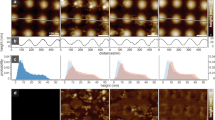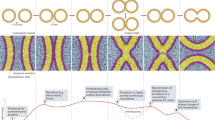Abstract
Membrane fusion occurs when SNAREpins fold up between lipid bilayers. How much energy is generated during SNAREpin folding and how this energy is coupled to the fusion of apposing membranes is unknown. We have used a surface forces apparatus to determine the energetics and dynamics of SNAREpin formation and characterize the different intermediate structures sampled by cognate SNAREs in the course of their assembly. The interaction energy–versus–distance profiles of assembling SNAREpins reveal that SNARE motifs begin to interact when the membranes are 8 nm apart. Even after very close approach of the bilayers (∼2–4 nm), the SNAREpins remain partly unstructured in their membrane-proximal region. The energy stabilizing a single SNAREpin in this configuration (35 kBT) corresponds closely with the energy needed to fuse outer but not inner leaflets (hemifusion) of pure lipid bilayers (40–50 kBT).
This is a preview of subscription content, access via your institution
Access options
Subscribe to this journal
Receive 12 print issues and online access
$189.00 per year
only $15.75 per issue
Buy this article
- Purchase on Springer Link
- Instant access to full article PDF
Prices may be subject to local taxes which are calculated during checkout





Similar content being viewed by others
References
Sollner, T., Bennett, M.K., Whiteheart, S.W., Scheller, R.H. & Rothman, J.E. A protein assembly-disassembly pathway in-vitro that may correspond to sequential steps of synaptic vesicle docking, activation, and fusion. Cell 75, 409–418 (1993).
Weber, T. et al. SNAREpins: minimal machinery for membrane fusion. Cell 92, 759–772 (1998).
Chernomordik, L.V. & Kozlov, M.M. Protein-lipid interplay in fusion and fission of biological membranes. Annu. Rev. Biochem. 72, 175–207 (2003).
Tamm, L.K., Crane, J. & Kiessling, V. Membrane fusion: a structural perspective on the interplay of lipids and proteins. Curr. Opin. Struct. Biol. 13, 453–466 (2003).
Cohen, F.S. & Melikyan, G.B. The energetics of membrane fusion from binding, through hemifusion, pore formation, and pore enlargement. J. Membr. Biol. 199, 1–14 (2004).
Sollner, T. et al. SNAP receptors implicated in vesicle targeting and fusion. Nature 362, 318–324 (1993).
Brunger, A.T. Structure and function of SNARE and SNARE-interacting proteins. Q. Rev. Biophys. 38, 1–47 (2005).
Jackson, M.B. & Chapman, E.R. Fusion pores and fusion machines in Ca2+-triggered exocytosis. Annu. Rev. Biophys. Biomol. Struct. 35, 135–160 (2006).
Hu, C. et al. Fusion of cells by flipped SNAREs. Science 300, 1745–1749 (2003).
Fasshauer, D., Otto, H., Eliason, W.K., Jahn, R. & Brunger, A.T. Structural changes are associated with soluble N-ethylmaleimide-sensitive fusion protein attachment protein receptor complex formation. J. Biol. Chem. 272, 28036–28041 (1997).
Dulubova, I. et al. A conformational switch in syntaxin during exocytosis: role of munc18. EMBO J. 18, 4372–4382 (1999).
Hazzard, J., Sudhof, T.C. & Rizo, J. NMR analysis of the structure of synaptobrevin and of its interaction with syntaxin. J. Biomol. NMR 14, 203–207 (1999).
Poirier, M.A. et al. The synaptic SNARE complex is a parallel four-stranded helical bundle. Nat. Struct. Biol. 5, 765–769 (1998).
Sutton, R.B., Fasshauer, D., Jahn, R. & Brunger, A.T. Crystal structure of a SNARE complex involved in synaptic exocytosis at 2.4 Å resolution. Nature 395, 347–353 (1998).
Hanson, P.I., Roth, R., Morisaki, H., Jahn, R. & Heuser, J.E. Structure and conformational changes in NSF and its membrane receptor complexes visualized by quick-freeze/deep-etch electron microscopy. Cell 90, 523–535 (1997).
Hua, S.Y. & Charlton, M.P. Activity-dependent changes in partial VAMP complexes during neurotransmitter release. Nat. Neurosci. 2, 1078–1083 (1999).
Xu, T. et al. Inhibition of SNARE complex assembly differentially affects kinetic components of exocytosis. Cell 99, 713–722 (1999).
Chen, Y.A., Scales, S.J. & Scheller, R.H. Sequential SNARE assembly underlies priming and triggering of exocytosis. Neuron 30, 161–170 (2001).
Melia, T.J. et al. Regulation of membrane fusion by the membrane-proximal coil of the t-SNARE during zippering of SNAREpins. J. Cell Biol. 158, 929–940 (2002).
Sorensen, J.B. et al. Sequential N- to C-terminal SNARE complex assembly drives priming and fusion of secretory vesicles. EMBO J. 25, 955–966 (2006).
Pobbati, A.V., Stein, A. & Fasshauer, D. N- to C-terminal SNARE complex assembly promotes rapid membrane fusion. Science 313, 673–676 (2006).
Fasshauer, D., Antonin, W., Subramaniam, V. & Jahn, R. SNARE assembly and disassembly exhibit a pronounced hysteresis. Nat. Struct. Biol. 9, 144–151 (2002).
Liu, W. et al. Single molecule mechanical probing of the SNARE protein interactions. Biophys. J. 91, 744–758 (2006).
Yersin, A. et al. Interactions between synaptic vesicle fusion proteins explored by atomic force microscopy. Proc. Natl. Acad. Sci. USA 100, 8736–8741 (2003).
Israelachvili, J.N. Intermolecular and Surface Forces (Academic Press, London, 1992).
Israelachvili, J.N. & Adams, G.E. Measurement of forces between 2 mica surfaces in aqueous-electrolyte solutions in range 0–100 nm. J. Chem. Soc. Farad. Trans. I 74, 975–1001 (1978).
Grote, E., Baba, M., Ohsumi, Y. & Novick, P.J. Geranylgeranylated SNAREs are dominant inhibitors of membrane fusion. J. Cell Biol. 151, 453–465 (2000).
McNew, J.A. et al. Close is not enough: SNARE-dependent membrane fusion requires an active mechanism that transduces force to membrane anchors. J. Cell Biol. 150, 105–117 (2000).
Bowen, M.E., Weninger, K., Brunger, A.T. & Chu, S. Single molecule observation of liposome-bilayer fusion thermally induced by soluble N-ethyl maleimide sensitive-factor attachment protein receptors (SNAREs). Biophys. J. 87, 3569–3584 (2004).
Rettig, J. & Neher, E. Emerging roles of presynaptic proteins in Ca++-triggered exocytosis. Science 298, 781–785 (2002).
Ashery, U. et al. Munc13–1 acts as a priming factor for large dense-core vesicles in bovine chromaffin cells. EMBO J. 19, 3586–3596 (2000).
Rizzoli, S.O. & Betz, W.J. Synaptic vesicle pools. Nat. Rev. Neurosci. 6, 57–69 (2005).
Shen, J., Tareste, D.C., Paumet, F., Rothman, J.E. & Melia, T.J. Selective activation of cognate SNAREpins by Sec1/Munc18 proteins. Cell 128, 183–195 (2007).
Derjaguin, B.V., Muller, V.M. & Toporov, Y.P. Effect of Contact Deformations on Adhesion of Particles. J. Colloid Interface Sci. 53, 314–326 (1975).
Maugis, D. Adhesion of spheres—the Jkr-Dmt transition using a dugdale model. J. Colloid Interface Sci. 150, 243–269 (1992).
Dolan, A.K. & Edwards, S.F. Theory of stabilization of colloids by adsorbed polymer. Proc. R. Soc. Lond. B Math. Phys. Eng. Sci. 337, 509–516 (1974).
Alexander, S. Adsorption of chain molecules with a polar head a-scaling description. J. Physique 38, 983–987 (1977).
Degennes, P.G. Polymers at an interface—a simplified view. Adv. Colloid Interface Sci. 27, 189–209 (1987).
Kuhl, T.L., Leckband, D.E., Lasic, D.D. & Israelachvili, J.N. Modulation of interaction forces between bilayers exposing short-chained ethylene-oxide headgroups. Biophys. J. 66, 1479–1488 (1994).
Takamori, S. et al. Molecular anatomy of a trafficking organelle. Cell 127, 831–846 (2006).
Millett, I.S., Doniach, S. & Plaxco, K.W. Toward a taxonomy of the denatured state: small angle scattering studies of unfolded proteins. Adv. Protein Chem. 62, 241–262 (2002).
Kohn, J.E. et al. Random-coil behavior and the dimensions of chemically unfolded proteins. Proc. Natl. Acad. Sci. USA 101, 12491–12496 (2004).
Fernandez, I. et al. Three-dimensional structure of an evolutionarily conserved N-terminal domain of syntaxin 1A. Cell 94, 841–849 (1998).
Margittai, M., Fasshauer, D., Pabst, S., Jahn, R. & Langen, R. Homo- and heterooligomeric SNARE complexes studied by site-directed spin labeling. J. Biol. Chem. 276, 13169–13177 (2001).
Xiao, W., Poirier, M.A., Bennett, M.K. & Shin, Y.K. The neuronal t-SNARE complex is a parallel four-helix bundle. Nat. Struct. Biol. 8, 308–311 (2001).
Margittai, M., Fasshauer, D., Jahn, R. & Langen, R. The Habc domain and the SNARE core complex are connected by a highly flexible linker. Biochemistry 42, 4009–4014 (2003).
Fitzkee, N.C. & Rose, G.D. Reassessing random-coil statistics in unfolded proteins. Proc. Natl. Acad. Sci. USA 101, 12497–12502 (2004).
Hanggi, P., Talkner, P. & Borkovec, M. Reaction-rate theory—50 years after Kramers. Rev. Mod. Phys. 62, 251–341 (1990).
Evans, E. Probing the relation between force–lifetime–and chemistry in single molecular bonds. Annu. Rev. Biophys. Biomol. Struct. 30, 105–128 (2001).
Hu, K. et al. Vesicular restriction of synaptobrevin suggests a role for calcium in membrane fusion. Nature 415, 646–650 (2002).
Kim, C.S., Kweon, D.H. & Shin, Y.K. Membrane topologies of neuronal SNARE folding intermediates. Biochemistry 41, 10928–10933 (2002).
Knecht, V. & Grubmuller, H. Mechanical coupling via the membrane fusion SNARE protein syntaxin 1A: a molecular dynamics study. Biophys. J. 84, 1527–1547 (2003).
Marrink, S.J., Berger, O., Tieleman, P. & Jahnig, F. Adhesion forces of lipids in a phospholipid membrane studied by molecular dynamics simulations. Biophys. J. 74, 931–943 (1998).
Rizo, J., Chen, X. & Arac, D. Unraveling the mechanisms of synaptotagmin and SNARE function in neurotransmitter release. Trends Cell Biol. 16, 339–350 (2006).
Pincet, F., Perez, E., Bryant, G., Lebeau, L. & Mioskowski, C. Long-range attraction between nucleosides with short-range specificity: Direct measurements. Phys. Rev. Lett. 73, 2780–2783 (1994).
Tareste, D. et al. Energy of hydrogen bonds probed by the adhesion of functionalized lipid layers. Biophys. J. 83, 3675–3681 (2002).
Helm, C.A., Knoll, W. & Israelachvili, J.N. Measurement of ligand-receptor interactions. Proc. Natl. Acad. Sci. USA 88, 8169–8173 (1991).
Sivasankar, S., Brieher, W., Lavrik, N., Gumbiner, B. & Leckband, D. Direct molecular force measurements of multiple adhesive interactions between cadherin ectodomains. Proc. Natl. Acad. Sci. USA 96, 11820–11824 (1999).
Giraudo, C.G., Eng, W.S., Melia, T.J. & Rothman, J.E. A clamping mechanism involved in SNARE-dependent exocytosis. Science 313, 676–680 (2006).
Kozlovsky, Y. & Kozlov, M.M. Stalk model of membrane fusion: solution of energy crisis. Biophys. J. 82, 882–895 (2002).
Marra, J. Controlled deposition of lipid monolayers and bilayers onto mica and direct force measurements between galactolipid bilayers in aqueous-solutions. J. Colloid Interface Sci. 107, 446–458 (1985).
Acknowledgements
This work was supported by the Human Frontier Science Program, a travel grant from US National Science Foundation, and US National Institutes of Health grants to J.E.R. We thank J. McNew (Rice University) for the generous gift of the plasmids used in this study, and A. Martin-Molina, A. Yamamoto and D. You for experimental help and many fruitful discussions.
Author information
Authors and Affiliations
Corresponding author
Supplementary information
Supplementary Text and Figures
Supplementary Figures 1–6, Supplementary Table 1, Supplementary Data, Supplementary Methods (PDF 612 kb)
Rights and permissions
About this article
Cite this article
Li, F., Pincet, F., Perez, E. et al. Energetics and dynamics of SNAREpin folding across lipid bilayers. Nat Struct Mol Biol 14, 890–896 (2007). https://doi.org/10.1038/nsmb1310
Received:
Accepted:
Published:
Issue Date:
DOI: https://doi.org/10.1038/nsmb1310
This article is cited by
-
Vesicle trafficking and vesicle fusion: mechanisms, biological functions, and their implications for potential disease therapy
Molecular Biomedicine (2022)
-
Extreme parsimony in ATP consumption by 20S complexes in the global disassembly of single SNARE complexes
Nature Communications (2021)
-
The glutamatergic synapse: a complex machinery for information processing
Cognitive Neurodynamics (2021)
-
Focused clamping of a single neuronal SNARE complex by complexin under high mechanical tension
Nature Communications (2018)



